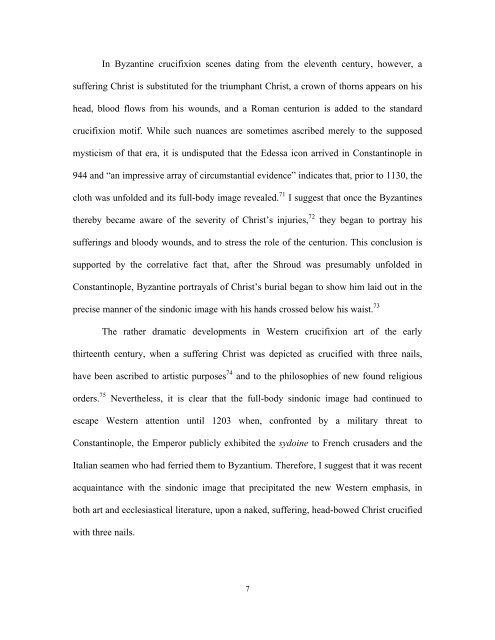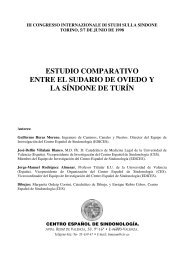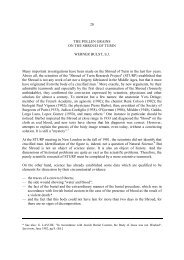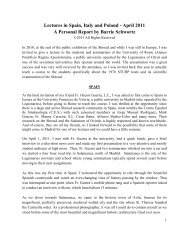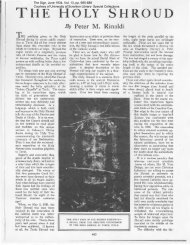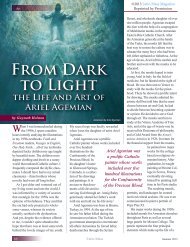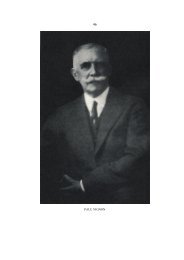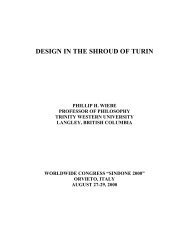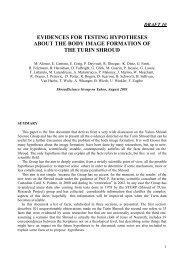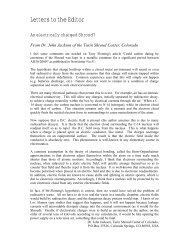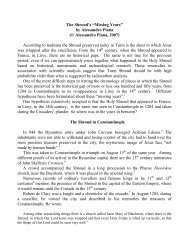the cathar crucifix - The Shroud of Turin
the cathar crucifix - The Shroud of Turin
the cathar crucifix - The Shroud of Turin
You also want an ePaper? Increase the reach of your titles
YUMPU automatically turns print PDFs into web optimized ePapers that Google loves.
In Byzantine <strong>crucifix</strong>ion scenes dating from <strong>the</strong> eleventh century, however, a<br />
suffering Christ is substituted for <strong>the</strong> triumphant Christ, a crown <strong>of</strong> thorns appears on his<br />
head, blood flows from his wounds, and a Roman centurion is added to <strong>the</strong> standard<br />
<strong>crucifix</strong>ion motif. While such nuances are sometimes ascribed merely to <strong>the</strong> supposed<br />
mysticism <strong>of</strong> that era, it is undisputed that <strong>the</strong> Edessa icon arrived in Constantinople in<br />
944 and “an impressive array <strong>of</strong> circumstantial evidence” indicates that, prior to 1130, <strong>the</strong><br />
cloth was unfolded and its full-body image revealed. 71 I suggest that once <strong>the</strong> Byzantines<br />
<strong>the</strong>reby became aware <strong>of</strong> <strong>the</strong> severity <strong>of</strong> Christ’s injuries, 72 <strong>the</strong>y began to portray his<br />
sufferings and bloody wounds, and to stress <strong>the</strong> role <strong>of</strong> <strong>the</strong> centurion. This conclusion is<br />
supported by <strong>the</strong> correlative fact that, after <strong>the</strong> <strong>Shroud</strong> was presumably unfolded in<br />
Constantinople, Byzantine portrayals <strong>of</strong> Christ’s burial began to show him laid out in <strong>the</strong><br />
precise manner <strong>of</strong> <strong>the</strong> sindonic image with his hands crossed below his waist. 73<br />
<strong>The</strong> ra<strong>the</strong>r dramatic developments in Western <strong>crucifix</strong>ion art <strong>of</strong> <strong>the</strong> early<br />
thirteenth century, when a suffering Christ was depicted as crucified with three nails,<br />
have been ascribed to artistic purposes 74 and to <strong>the</strong> philosophies <strong>of</strong> new found religious<br />
orders. 75 Never<strong>the</strong>less, it is clear that <strong>the</strong> full-body sindonic image had continued to<br />
escape Western attention until 1203 when, confronted by a military threat to<br />
Constantinople, <strong>the</strong> Emperor publicly exhibited <strong>the</strong> sydoine to French crusaders and <strong>the</strong><br />
Italian seamen who had ferried <strong>the</strong>m to Byzantium. <strong>The</strong>refore, I suggest that it was recent<br />
acquaintance with <strong>the</strong> sindonic image that precipitated <strong>the</strong> new Western emphasis, in<br />
both art and ecclesiastical literature, upon a naked, suffering, head-bowed Christ crucified<br />
with three nails.<br />
7


